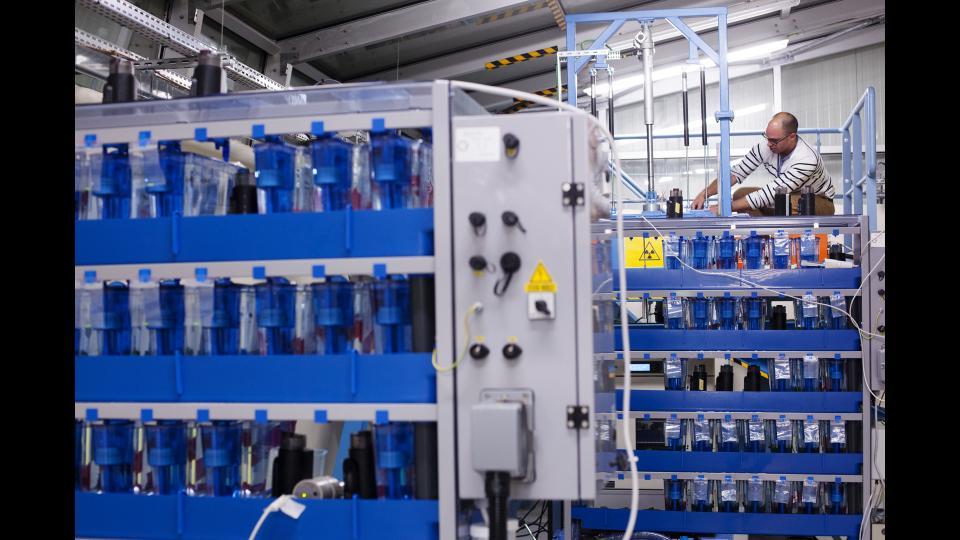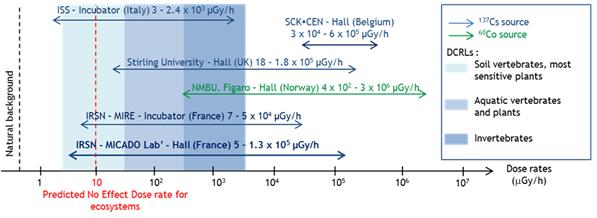The experimental platform MICADO LAB
MICADO'Lab (French acronym for Chronic irradiation facility for laboratory studies of the dose-effect relationship) is an external gamma irradiation platform designed for studying the effects on ecosystems of chronic exposure to ionising radiation.
Context and research purpose
Radioprotection of the environment has been integrated into the new basic standards for radiological protection at international (IAEA, 2014) and European (European Council, 2014) levels. In the context of impact assessment and monitoring, ecosystems and lower organisational levels (populations, species) now need to be protected from chronic exposure to radioactive substances. Thus, realistic effect criteria are needed to limit uncertainties in the ecological risk assessment.
Basic knowledge of the effects of ionising radiation on living organisms therefore needs to be improved, in accordance with the strategic research agenda for radioecology and with the recent IRSN report on the state of the art in radiation protection of the environment.
However, studies in this area are faced with theoretical and methodological hurdles linked particularly to differences in species sensitivity and the exposure conditions of organisms (dose rates and duration).
The MICADO Lab facility was designed to allow the chronic irradiation of different biological models representative of the species found in ecosystems, at dose rates ranging from background radiation to 100 mGy/h.
Platform description
The irradiator
The MICADO Lab platform is located at the Cadarache site (France).
It consists of an air-conditioned irradiation hall measuring 4 m in width, 35 m in length and 5 m in height, which is able to accommodate experimental equipment suitable for the exposure of different biological models (cell cultures, plants and animals).
Four 137Cs sources are used to irradiate organisms at dose rates ranging from 5 µGy/h to 100 mGy/h

The irradiation period of between a few hours and several weeks means that chronic exposure of one or more generations can be carried out.
MICADO Lab has links to a cellular biology laboratory and an analysis platform consisting of physiology, cellular and molecular biology, biochemistry and microscopy laboratories, which are essential for characterising radiation-induced effects at different biological levels.

Animal housing facility
MICADO Lab is also linked to fish and invertebrate breeding facilities. The species routinely used at the Radionuclide Ecotoxicology Laboratory (LECO) are the zebrafish Danio rerio, the nematode Caenorhabditis elegans and the daphnid Daphnia magna.
The first two species are animal models traditionally used in genetics, toxicology and/or evolutionary biology. Their genomes have been fully sequenced and many genetic engineering tools are available; in parallel, their physiology and biology have been completely characterised.
The micro-crustacean Daphnia magna is an omnipresent environmental bioindicator in freshwater and is commonly used in ecotoxicology.
Comparison of MICADO Lab and other European facilities

MICADO’Lab offers unique exposure conditions that complement the conditions offered by other European facilities, particularly in terms of the radiation energy and the range of dose rates that can be applied.
In particular, it allows dose rates that are below the predicted no effect dose rate for ecosystems.
Research axes
Four main research axes have been developed using the MICADO’Lab facility, and these will be complemented by collaborative research within European projects.
Axis 1: evaluation of ionising radiation effects from biomolecule to individual level
The studies aim to characterize relevant biomarkers for predicting the effects of ionising radiation on the main biological functions sustaining population dynamics (links between proteins/reproduction and survival in the ISATIS project, links between genomes and epigenomes/embryonic development (EpiTox project), reproduction (ReproTox project) and neurogenesis (MENINGES project)).
Axis 2: transgenerational impact and adaptation mechanisms
This axis aims to identify the mechanisms that govern transgenerational effects (heritability, adaptation), a major issue for ecosystems chronically exposed to ionising radiation. The role played by mutations and epigenetic changes is studied in different organisms that use clonal reproduction (in daphnids in the EpiDaph project) or are hermaphrodites (in the nematode C. elegans in the 3E-Gen project), for exposure periods ranging respectively from 4 to more than 30 generations (REPERE project).
Axis 3: species radiosensitivity and interspecific variability
This axis aims to better characterise the key mechanisms governing species radiosensitivity, since this is one of the pillars of ecological protection, which is holistic by nature. The approach is based on species metabolism (EMERIC project).
Axis 4: effects of ionising radiation on ecosystemic functions
This axis looks at the sustainability of ecosystem structure and functions, based on an integrative approach analysing organic matter decomposition processes (IDILIC project).
Facility specifications
- Irradiation sources: 137Cs
- Total radioactivity: 444 GBq
- Possible dose rates: 5 µGy/h to 100 mGy/h
- Possible irradiation period: a few hours to several months
- Experiment hall: 4 m (width) x 35 m (length) x 5m (height)
- Lighting and temperature controlled according to the ecosystem being studied
- Fish housing facility and invertebrate breeding facility
- Species routinely used: the fish Danio rerio, the nematode Caenorhabditis elegans and the daphnid Daphnia magna
